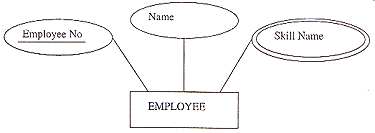| (a) | (i) What is multi-valued attribute? (ii) Give an example of a simple E-R diagram to show how a multi-valued attribute would be represented. Explain how this representation would be changed by normalization. |
[1] [3] |
| (i) Multivalued Attribute: an attribute that have more than one value for each entity instance
|
||
| (ii) Multi-valued attribute representation.
Normalization representation
|
||
| (b) | Give four reasons why normalization is carried out. | [4] |
Reasons for
normalization:
|
||
| (c) | Identify four models used in database modelling. | [4] |
Four models used in
Database Modelling:
|
||
| (d) | What is meant by concurrency control? | [2] |
| Concurrency control :
prevent of the loss of data integrity (1 mark) due to interference between users in a
multi-user envionrment (1 mark).
|
||
| (e) | State the Entity Integrity Rule. | [2] |
| Entity Integrity Rule
: no component of the primary key of a relation can be given null values.
|
||
| (f) | List four operations that can be executed by the Data Definition Language (DDL) component of the Structured Query Language (SQL). | [4] |
Possible Data
Definition Language (DDL) operations are:
|

